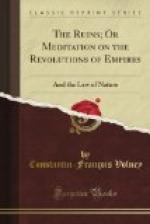* The reader will doubtless
see with pleasure some examples
of ancient hieroglyphics.
“The Egyptians (says Hor-appolo) represent eternity by the figures of the sun and moon. They designate the world by the blue serpent with yellow scales (stars, it is the Chinese Dragon). If they were desirous of expressing the year, they drew a picture of Isis, who is also in their language called Sothis, or dog-star, one of the first constellations, by the rising of which the year commences; its inscription at Sais was, It is I that rise in the constellation of the Dog.
“They also represent the year by a palm tree, and the month by one of its branches, because it is the nature of this tree to produce a branch every month. They farther represent it by the fourth part of an acre of land.” The whole acre divided into four denotes the bissextile period of four years. The abbreviation of this figure of a field in four divisions, is manifestly the letter ha or het, the seventh in the Samaritan alphabet; and in general all the letters of the alphabet are merely astronomical hieroglyphics; and it is for this reason that the mode of writing is from right to left, like the march of the stars. —“They denote a prophet by the image of a dog, because the dog star (Anoubis) by its rising gives notice of the inundation. Noubi, in Hebrew signifies prophet—They represent inundation by a lion, because it takes place under that sign: and hence, says Plutarch, the custom of placing at the gates of temples figures of lions with water issuing from their mouths.—They express the idea of God and destiny by a star. They also represent God, says Porphyry, by a black stone, because his nature is dark and obscure. All white things express the celestial and luminous Gods: all circular ones the world, the moon, the sun, the orbits; all semicircular ones, as bows and crescents are descriptive of the moon. Fire and the Gods of Olympus they represent by pyramids and obelisks (the name of the sun, Baal, is found in this latter word): the sun by a cone (the mitre of Osiris): the earth, by a cylinder (which revolves): the generative power of the air by the phalus, and that of the earth by a triangle, emblem of the female organ. Euseb. Proecep. Evang. p. 98.
“Clay, says Jamblicus
de Symbolis, sect. 7, c. 2. denotes
matter, the generative
and nutrimental power, every thing
which receives the warmth
and fermentation of life.”
“A man sitting upon the Lotos or Nenuphar, represents the moving spirit (the sun) which, in like manner as that plant lives in the water without any communication with clay, exists equally distinct from matter, swimming in empty space, resting on itself: it is round also in all its parts, like the leaves, the flowers, and the fruit of the Lotos. (Brama has the eyes of the Lotos, says Chasler Nesdirsen, to denote his intelligence: his eye swims




